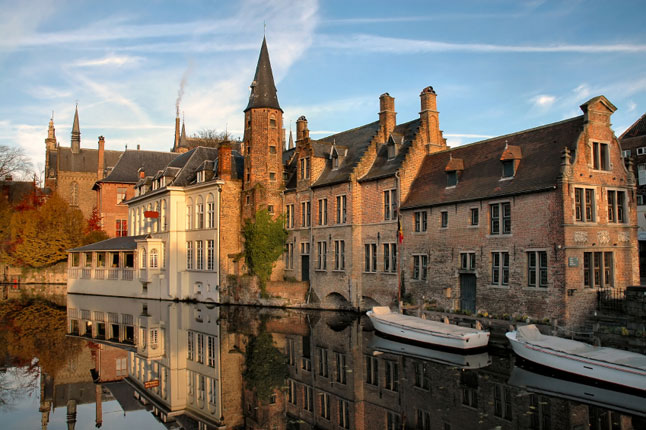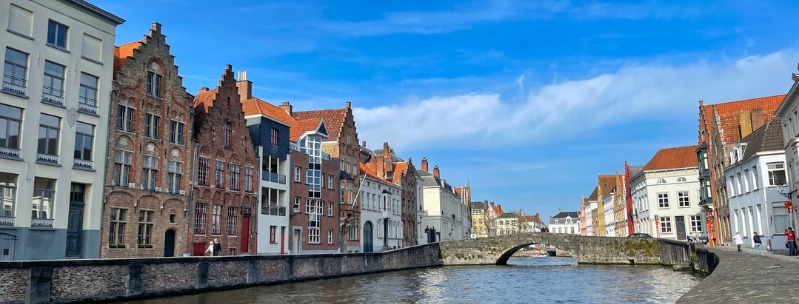Top Things to See and Do in Bruges
Situated in the heart of Belgium’s West Flanders province is the city of Bruges. Not only is it the largest city in the province, but it is also the capital of Belgium. The city is a famous UNESCO World Heritage Site, and a population of over 100,000 thrive in this metropolitan area.
Historically, Bruges has been called ‘the Venice of the north’, and just like many other water-based cities it has a number of canals within its walls. Thanks to these waterways, Venice was once the chief commercial city of the world; its port continues to be of significant economic importance.
Bruges was first fortified after Julius Caesar conquered Menapii in the first century BC, and this was to protect the coastal area from pirates. There is very little evidence of human activity in Bruges before the Roman Gaul era, and over the years it has undertaken a number of inhabitants, from the Franks to the Vikings.
Millions of tourists visit Bruges every year, and with its medieval rooftops and beautiful scenery it’s easy to see why. There are a number of things in Bruges that will keep even the most hardened tourist entertained for hours, from Flemish masterpieces to chocolate shops. Take a look at some of the must-see attractions!
The Market Square
The market square is in the heart of Bruges, and is situated around a statue celebrating heroes of Battle of the Golden Spurs Pieter de Coninc and Jan Breydel. In 1302, French Belgium was forced to recognise the Flemish emancipation and the period houses that surround the market square reflect the stunning architecture of the time.
The Provincial Court lies to the west of the market square, and this enchanting building was built in a neo-gothic style reflecting 19th century architecture. The rest of the square is surrounded by boutique hotels, cafes, restaurants and stalls, where tourists flock to taste the home-cooking of the locals and the sweetness of the city’s beer.
The Belfry Tower
The Belfry Tower was originally built in 1220, but underwent a number of reconstructions because of fire and weather damage. The final stone to complete the reconstruction was added in 1821, and other than a bell tower, the structure has also been used as a watch tower and a market in the 13th century.
The 366 step climb to the top offers an amazing view of the city, and you’ll be able to catch your breath in a number of historical rooms along the way. If you can stand the sound of the extremely loud bells, they provide an excellent backdrop for the beautiful view at the top. On a clear day, you can even see the North Sea!
The Saint John Hospital
This historical and famous hospital was built in 1188, and was used by passers-by and pilgrims in need of medical assistance or religious blessing before death. Run by nuns and monks, the hospital was in use all the way through the 19th Century until a new one was built. Thankfully however, this old structure still remains enacted, and there are even audio guides to help you on your tour!
About Bruges
“Somewhere within the dingy casing lay the ancient city”, wrote Graham Greene of BRUGES , “like a notorious jewel, too stared at, talked of, trafficked over.” And it’s true that Bruges’ reputation as one of the most perfectly preserved medieval cities in western Europe has made it the most popular tourist destination in Belgium, packed with visitors throughout the summer.
Inevitably, the crowds tend to overwhelm the town’s charms, but you would be mad to come to Flanders and miss the place: its museums, to name just one attraction, hold some of the country’s finest collections of Flemish art; and its intimate, winding streets, woven around a pattern of narrow canals and lined with gorgeous ancient buildings, live up to even the most inflated hype.

By the fourteenth century, Bruges shared effective control of the cloth trade with its two great rivals, Ghent and Ypres, turning high-quality English wool into thousands of items of clothing that were exported all over the known world. It was an immensely profitable business, and made the city a center of international trade: at its height, the town was a key member of the Hanseatic League, the most powerful economic alliance in medieval Europe. By the end of the fifteenth century, though, Bruges was in decline, partly because of a recession in the cloth trade, but principally because the Zwin river – the city’s vital link to the North Sea – was silting up. By the 1530s the town’s sea trade had collapsed completely, and Bruges simply withered away. Frozen in time, Bruges escaped damage in both world wars to emerge the perfect tourist attraction.
Bruges is an excellent place to photograph. Located in the northwestern corner of Flemish Belgium, this small city is one of Europe’s most beautiful medieval cities. Here you will find old-fashioned white almshouses along cobbled streets, giving way to canals lined with weeping willows. While the city’s weather may leave something to be desired, Bruges is still a fantastic place to practice taking pictures.
Frozen in Time
Every alleyway, every narrow street, ever canal in Bruges would make a perfect picture. The unique angles of medieval buildings, the perpetually grey sky and leftover bits of bygone eras will surely make you feel inspired.
There are also many things to see in Bruges. For example, you can visit the Grote Markt, which is a main square surrounded by brightly painted buildings designed in the Flemish style. You can also pay a visit to the begijnhof, or convent, which sports gardens filled with daffodils and tulips in the spring. Or, visit one of the many little shops that specialize in handmade lace, which the city was known for during the 18th century, but is still produced today.
Bruges also offers plenty of options for fine dining. Flemish food has a reputation for being simple, fresh, and prepared with care, like a less flamboyant version of French cuisine. Belgian chocolates are particularly famous, and you can find many small chocolatiers around the city. At the same time, Belgium is known for its many varieties of beer, and Bruges is no exception. Some great places to try local brews include De Halve Maan, Staminee de Garre and De Kelk, which are all great places to sit and recharge after a long day of photographing the canals.
Beauty in the Rain
When photographing the city, make the weather work for you. Since Bruges receives an unbelievable amount of rain, you will have to be comfortable photographing in wet, dreary weather. Use an aperture that’s wide open to allow for enough light to keep your pictures from looking gloomy. Though the sky may be grey, look for ways to compose your pictures so that the sky becomes a grey backdrop that allows the architecture to pop. That way, you can show that this city can even look beautiful on the dreariest of days.
Picture perfect
Everywhere you turn in Bruges you could take a photo worthy of a postcard. Arguably Europe’s finest example of a preserved medieval city, the treasures you can find here are akin to those witnessed in a fairytale. The fact the whole city is a UNESCO World Heritage site is enough to consider a trip to the magic city.
If everywhere is ready for a snap can there be a number one photo opportunity? Well, of course, and that is found at the summit of 336 steps you claim when visiting the Market Halls and Belfry. It might be one hell of a climb but from the top you will be able to snap the Belguim capital at its finest.
Practical Tips
Like in many European cities, accommodation and travel in Bruges can be expensive for the budget traveler. However, there are plenty of cheap holiday offers available online, particularly if you book in advance. Also, if you’re taking the train and are under 26, you may qualify for a reduced rate.
This beautifully preserved city is waiting for you, Grab your camera and book a trip now. Who knows? You may even get to see Bruges on a rare sunny day.
